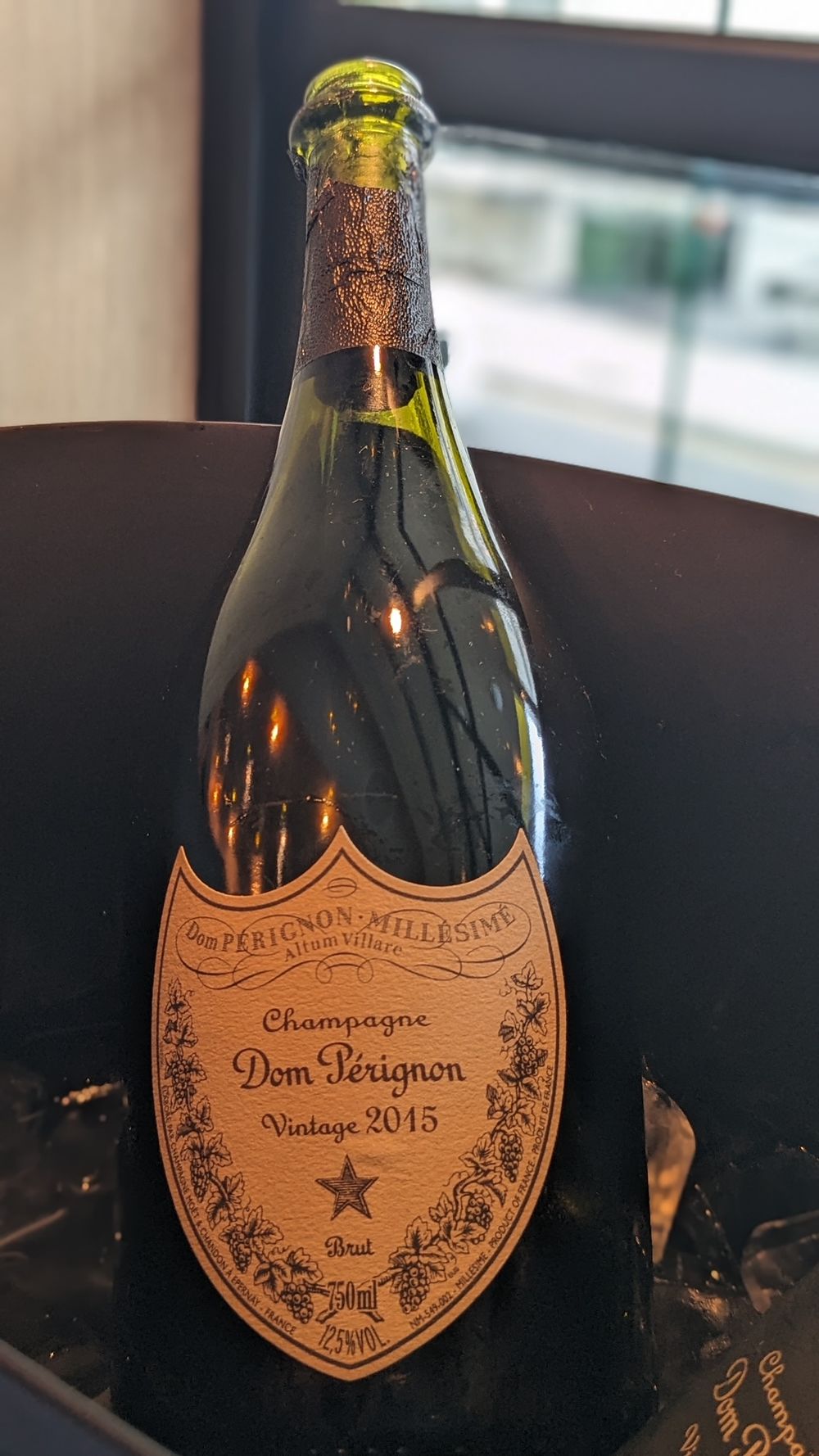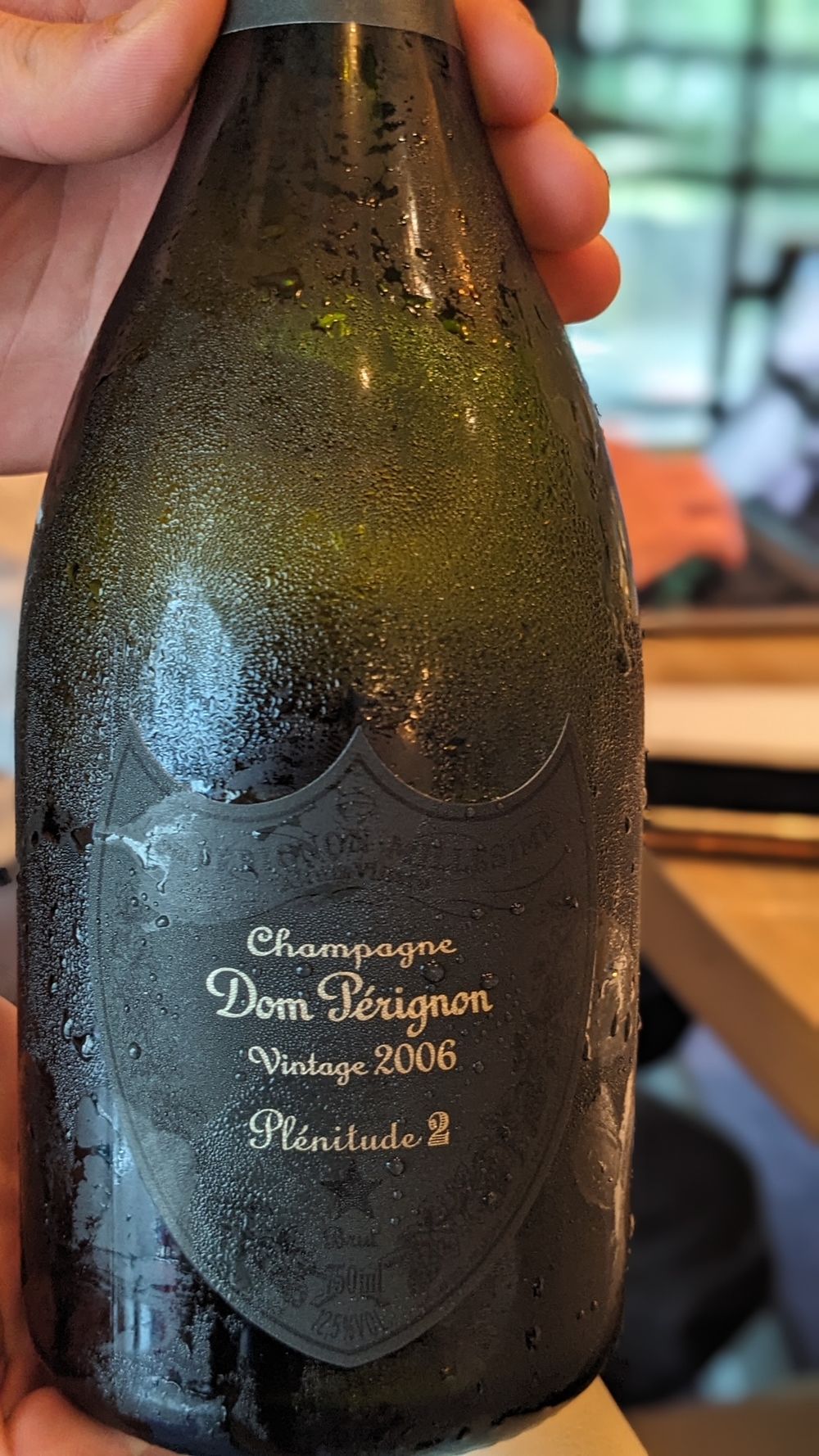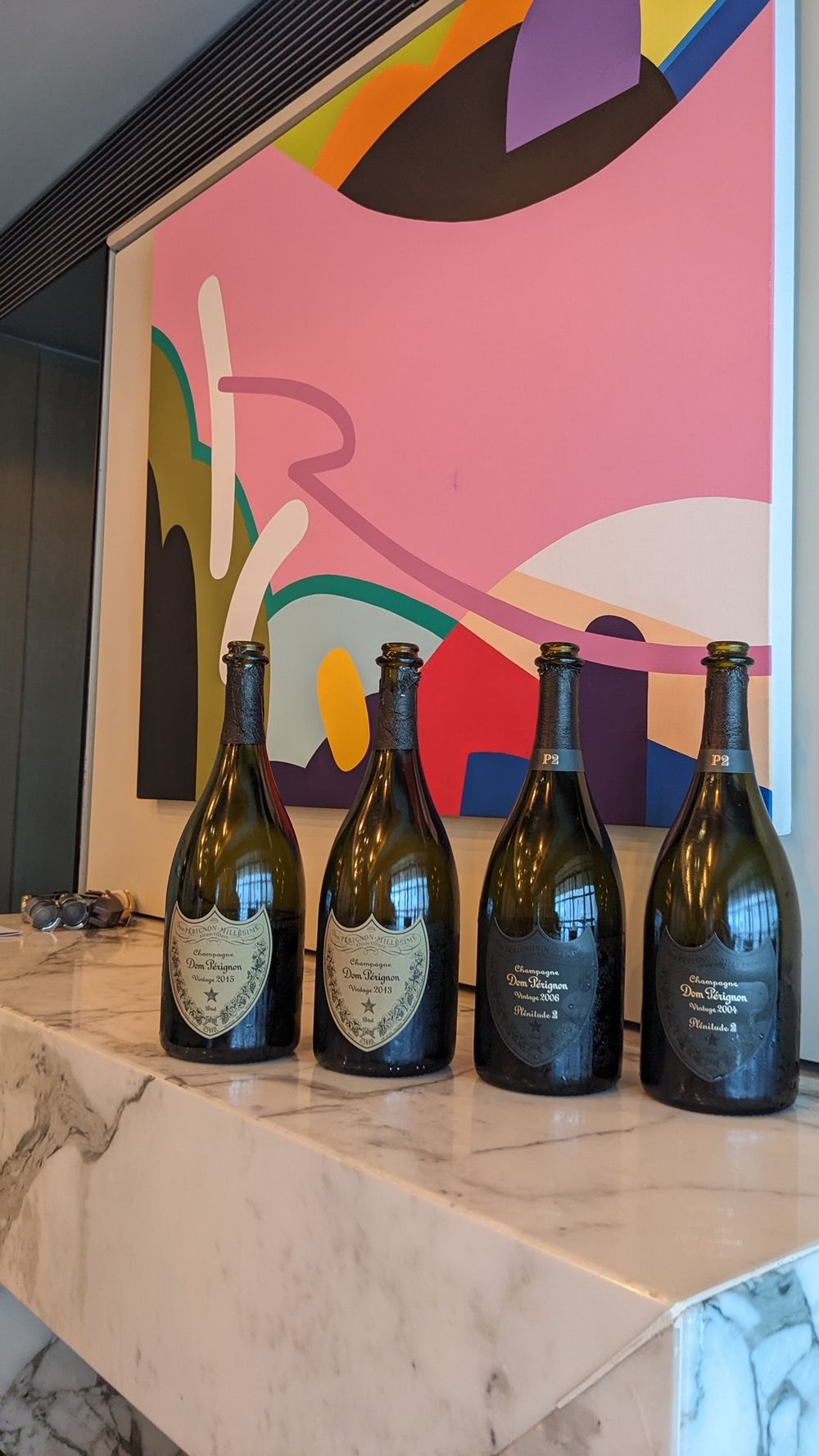New paradigms demand a new language and thus Vincent Chaperon, cellar master at Dom Pérignon, framed the launch of the 2015 vintage in terms of shape. Not only does he have a point, he has good reason, too, especially since he did not make a vintage in 2023 – but more of that later.
Chaperon supplied an honest picture of 2015, a challenging year where grapes suffered from dry stress in hot temperatures. Many 2015 Champagnes are looser-structured, rounded, with less cut and poise than usual, but since then, hot and challenging years followed, just think of 2017, 2018, 2020 and 2022 – setting new paradigms indeed that Dom Pérignon grapples with but still manages to pull off.

Dom Pérignon 2015 launch, London, July 15, 2024
Dom Pérignon 2015: A Mosaic
“When we think about 2015,” said Chaperon, “it really is sun exposure and another character of 2015 is drought, water deficiency. It was one of the longest periods of drought that we had in Champagne, from mid-spring to summer a continuous period without rain which really had an impact as a kind of prism in the behaviour of plots and villages.”
He noted that very localised rainfall and soil structure were decisive in that year. “There were parts that were too hot, too dry, which really suffered.”
He cited the contrasting site of La Côte in Aÿ, “just above the cemetery where we have 10 hectares on higher slopes, directly on chalk, very hot and dry. The vines were suffering, we had trouble with maturation, there were vegetal notes, harsh and aggressive phenolics. In [the villages of] Verzenay and Mailly which received more water, which are more exposed to east and northeast, with slightly deeper soils, it was better and we were able to pick more balanced grapes. It was like a mosaic.”

Selection was essential: Vincent Chaperon, cellar master
Appeasing and Intense
“2015 was a question of sorting, of selecting – and as you know with Dom Pérignon, we are very good in these years because we can select,” Chaperon said, referring to the vast array of sites that he has access to via the LVMH group. He also noted that Pinot Noir outperformed Chardonnay in 2015 but that access and the ability to select meant that there was a fairly equal share of both varieties in the 2015 blend, namely 51% Pinot Noir and 49% Chardonnay.
Despite very low levels of malic acid in such a warm year, the base wines went through full malo-lactic conversion. Chaperon noted that 2015 to him came across as both “appeasing and intense.” He explained this contradictory statement by likening his reaction to the wine to the impact the seascape photography of Japanese artist Hiroshi Sugimoto had on him, capturing “the intense emotion between the sea and the sky. There always are micro-asperities,” Chaperon said, even in a calm ocean, “and there are micro asperities in the wine.”
This prompted him to speak about the “more generosity, more softness, coming from the maturity of the fruit, the sensation of aromatic fruitiness that brings natural “sucrosity” and at the same time an element of phenolics” which in turn creates a kind of “bitterness” that “helps us build this full sensation of freshness and vibrancy.”

The 2006 Plénitude 2 was also launched alongside the DP 2015
Contrasts and shapes
The new Dom Pérignon 2015 release was poured alongside the contrasting 2013 vintage – a much cooler, later year with an October harvest. The new late-disgorged vintage Dom Pérignon 2006 Plénitude 2 – or P2 for short – also from a warm year, was contrasted with the 2004 P2 – from a cooler year.
“2015 and 2013 are very different,” Chaperon said. “So it is a stretch, but it is good to have a comparison – they are rather opposite vintages. 2003 had told us about the new scenario in Champagne of warmer vintages; 2006 and 2015 are two of them. But we discovered that heat is not everything, it depends on when you have water. 2006 was a warm year as well but very different from 2015. The character of the two vintages is very different,” he said, simply because there was sufficient rain.
“We had a lot of water at the end of August, to the point that we were a little afraid for the grapes not to mature. We had to wait after the rain. 2006 was about slowness, it is a bit technical but also philosophical, we had to wait for the picking, wait for the release, it was the first time we released a Dom Pérignon ten years after the harvest. There was a commitment from Richard [Geoffroy, Chaperon’s predecessor] to lengthen the maturation time, and the two further years gave us a lot more freshness, because there is high phenolic content in 2006. Ten years ago, when we were releasing it we were not feeling that, because 2006 always showed so much suppleness, to the point of viscosity.”
Chaperon then touched upon his idea of shape in describing the wines. He noted that both 2006 and 2015 were both “very tactile vintages with 2015 more rectilinear whereas 2006 is more about the curve.”
Tactility and the missing 2023 Vintage
Chaperon’s final point was about tactility – especially in the face of 2023, a year from which no Dom Pérignon vintage will be made. Chaperon made what he called a “patrimonial blend,” i.e. a vintage from 2023 for the house’s record or for a later, exceptional release. Considering the commercial ramifications, this cannot have been an easy decision.
“I never made it because I did not find sufficient tactility in 2023 – there was a matter of dilution,” he said and expanded further: “Tactility is the truth of Dom Pérignon, it is essential. The most important thing is how the wine is touching the palate and so we [he and his team] came back to explore. We changed the way we were tasting the still wine – we will stop smelling, go straight to taste and push the vocabulary of the wine, the way we describe the wine, the shape of the wine.”
He compared the palate to the finger tips and explained that there were six “directions” of tactility: first the shape, is it round or square; second the volume, is it wide or thin; third the suppleness, is it firm or mellow; fourth the weight, is it light or heavy, fifth the perceived temperature where alcohol has an impact and finally the sixth and last one – friction, which he explained as “the way you turn the wine in your mouth that allows you to define the grain of the wine which is super important.”
While this talk may sound absurd to some, Chaperon indeed has a point – and we all know how much Champagne has changed in the past ten, twenty and even thirty years. It will keep changing and new approaches are needed. The wines themselves were delicious. 2015 and 2006 can hook those who usually shy away from the bracing freshness of Champagne whereas 2013 and 2004 are for those who revel in it. 2004 P2 was my wine of the day. Exquisitely aromatic and simply delicious and elegant.

Dom Pérignon 2015, 12.5% ABV
51% Pinot Noir, 49% Chardonnay, disgorged in January 2023 after 8 years on lees with a dosage of 5 g/L
Rich creaminess on the nose reminds of a fragrant, freshly baked Mirabelle cheese tart, showing the ripeness of the baked plum and the caramelised yet tangy notion of the cheesecake. The palate is juicy, slightly loose in structure but concentrated, with fine mousse and creaminess, almost touching a notion of chalk. That tangy, creamy, slightly caramelised vibe of baked cheesecake reappears on the palate with a deep sense of umami. A rounded but complex wine with fine freshness. Absolutely open and ready to be enjoyed.
Dom Pérignon 2013, 12.5% ABV
51% Pinot Noir, 49% Chardonnay, disgorged in summer 2022 after 8 years on lees with a dosage of 5 g/L
A shy nose opens with a touch of moist, fresh moss on the nose. The palate gives a sense of vibrancy, of elegance, brightness and lasting freshness that is almost soothing in the embrace of smooth Dom Pérignon autolysis, almost more reminiscent of chalky stone than bread, creating a lovely equilibrium between poise and generosity. The sense of freshness seems to rest below the surface but is absolutely, eternally present. Elegant, slips down beautifully, fresh, with exceptional harmony.
Dom Pérignon Plénitude 2 2006, 12.5%
62% Pinot Noir, 38% Chardonnay, disgorged after approximately 15 years on lees with a dosage of 5 g/L
Freshly baked cookie crust is suffused with a lovely lift that almost, just almost, has an overtone of dried mint and a sense of chalk. With air, juicy plum fruit breaks though. The palate is mellow, with calm mousse, creamy, right now really soothing, with the gentlest bitterness, but, compared to some other 2006 wines, absolutely together, rounded but poised. Bravo.
Dom Pérignon Plénitude 2 2004, 12.5%
62% Pinot Noir, 38% Chardonnay, disgorged after approximately 15 years on lees with a dosage of 5 g/L
A wonderfully lifted nose brings a sense of chalk pervaded by moss and an ethereal overtone of dried chamomile. The palate is rounded, mellow but with a lovely, vivid well of freshness, an aromatic, herbal, lemony serenity that comes with much depth, anchored in both chalk and subtle autolysis. More temperature on the nose and palate makes that dried chamomile and crushed yarrow notion stronger, brighter, fresher. Simply exquisite, tender aromatic and so elegant.
































